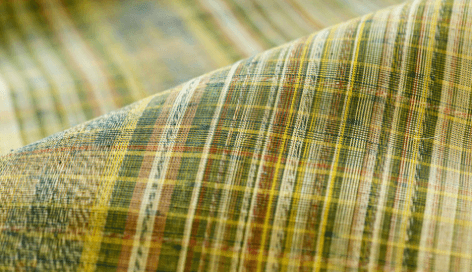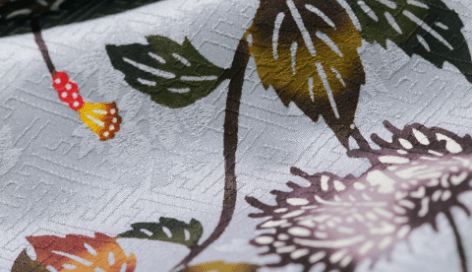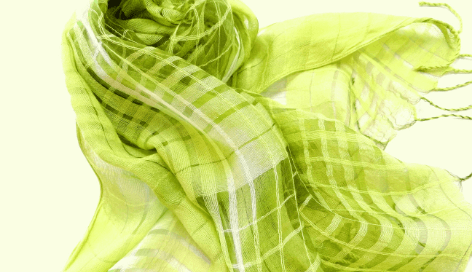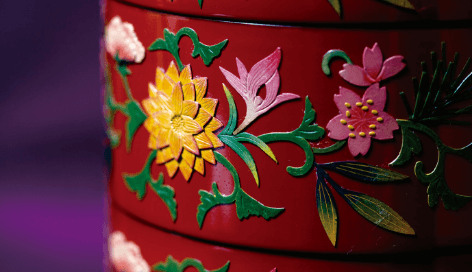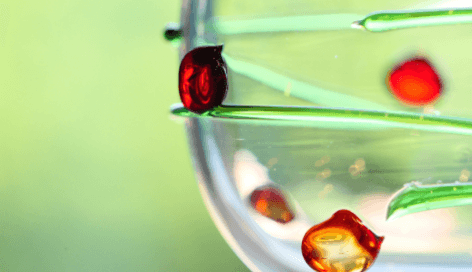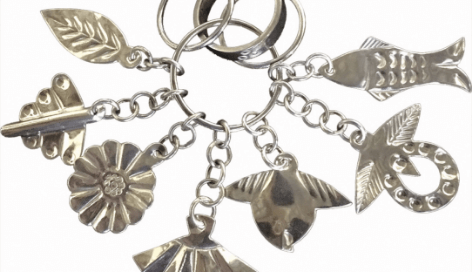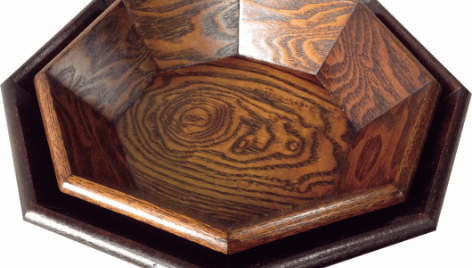Kijoka no Bashōfu
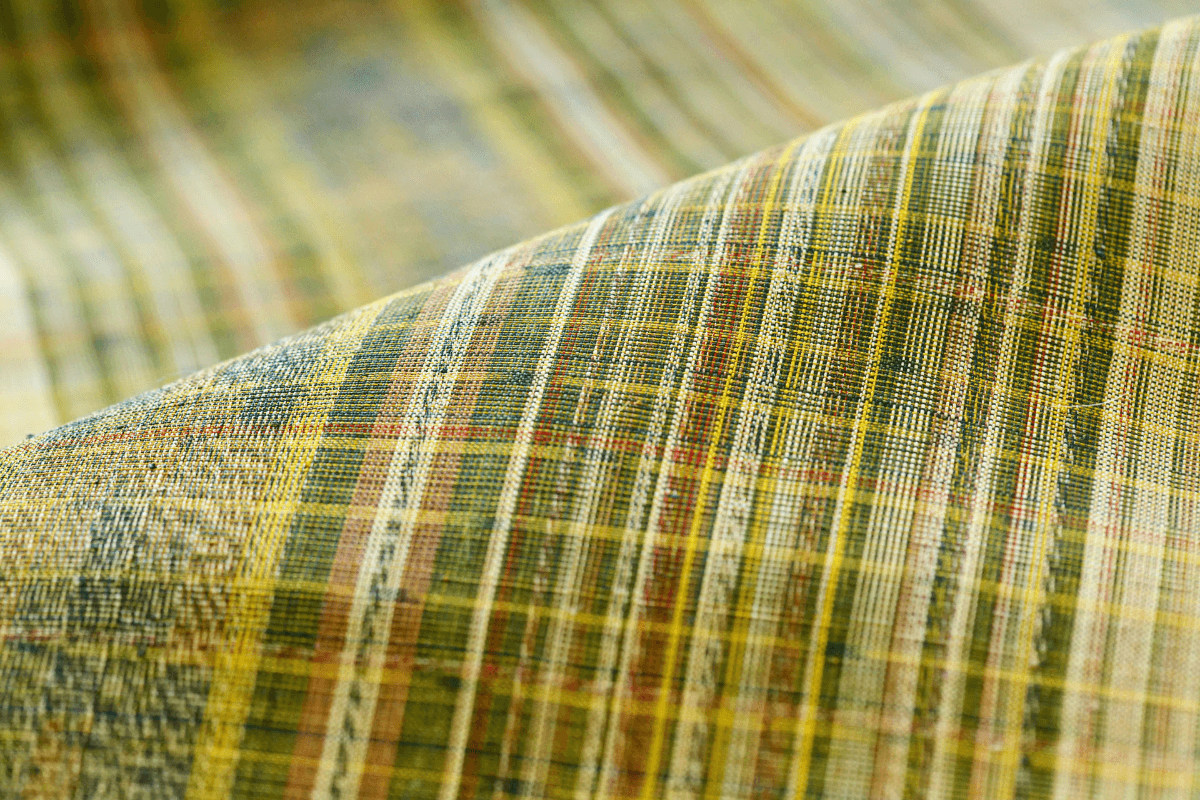
Originating in the 13th century, the Bashōfu fabric is made from the hand-spinning kasuri (ikat) threads, that are made from the bark of the Ito Bashō (fiber banana tree). After it is dyed with Ryukyu indigo, sharinbai (Rhaphiolepis indica var umbellate or Yeddo hawthorn), and other plant dyes, it is weaved into fabric. This woven fabric suits the Okinawa climate well and has been valued by locals since ancient time for its light and smooth texture.
Yuntanza Hana-ui(Yomitanzan Hana-ori)
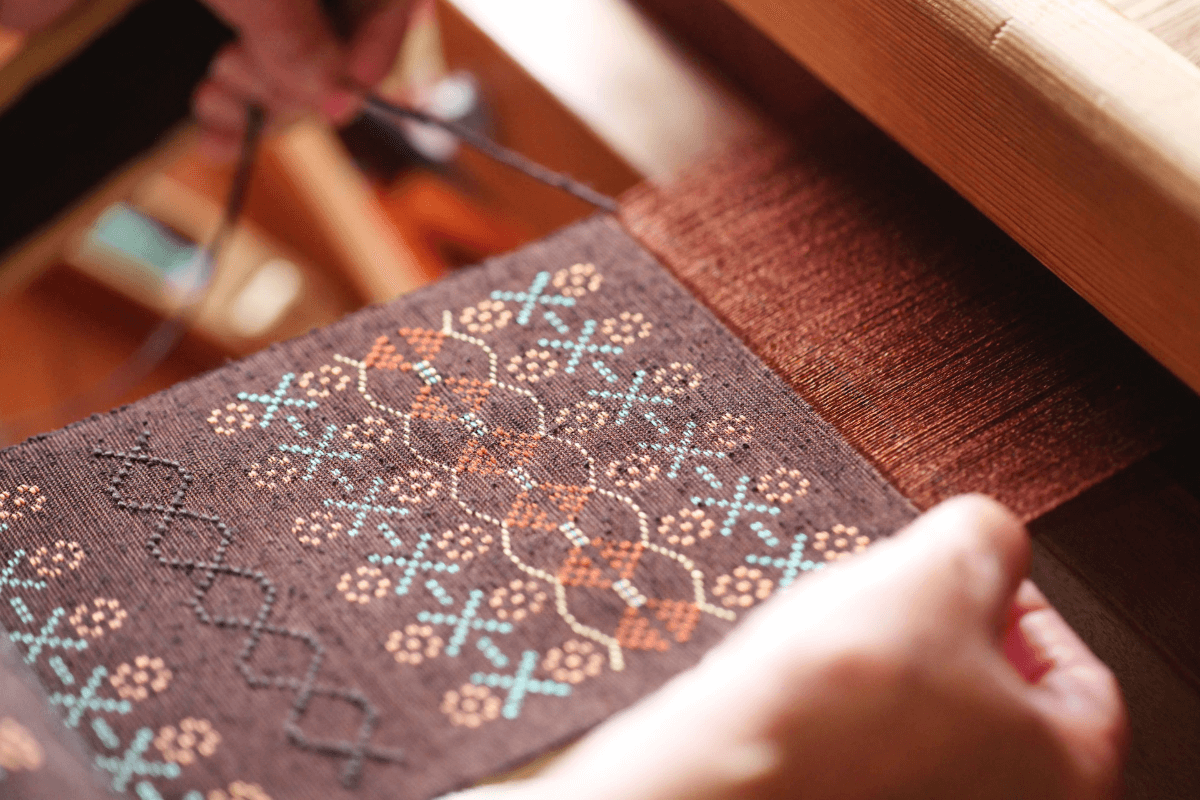
Originating in the 15th century, the Yuntanza Hana-ui was once created to be the official fabric of the Ryukyu Kingdom, which only the royal family, nobilities, and residents of Yomitan were allowed to wear. It is a tropical fabric made of silk and cotton thread with geometric patterns expressed with colored thread, and then decorated with Kasuri(Ikat), stripes, and plaid patterns.
Yuntanza Minsā
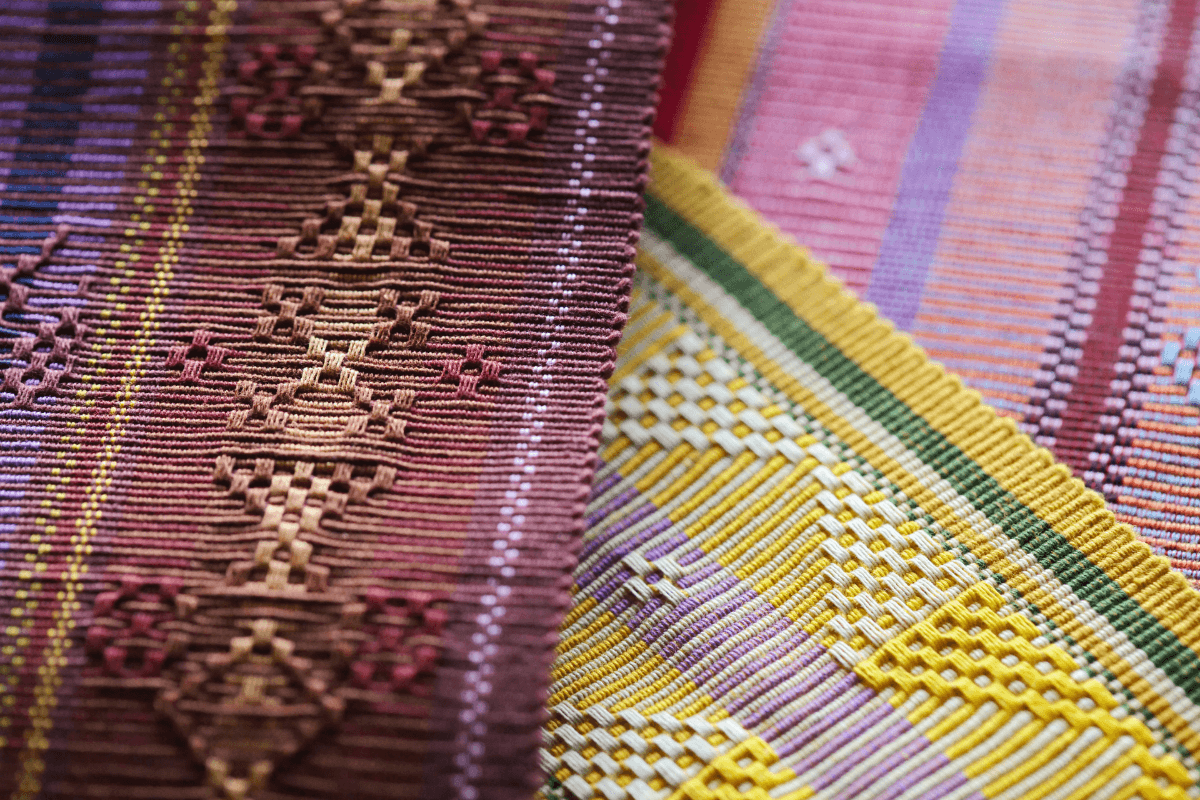
The Yuntanza Minsā originated around the same time as the Yuntanza Hana-ui and demonstrates strong influences from the Southeast Asia region. This fabric is made of cotton thread and a geometric, flower-like design that is woven into the warp using tools such as bamboo skewers. The word “Minsā” means a narrow belt or sash.
Chibana Hana-ori
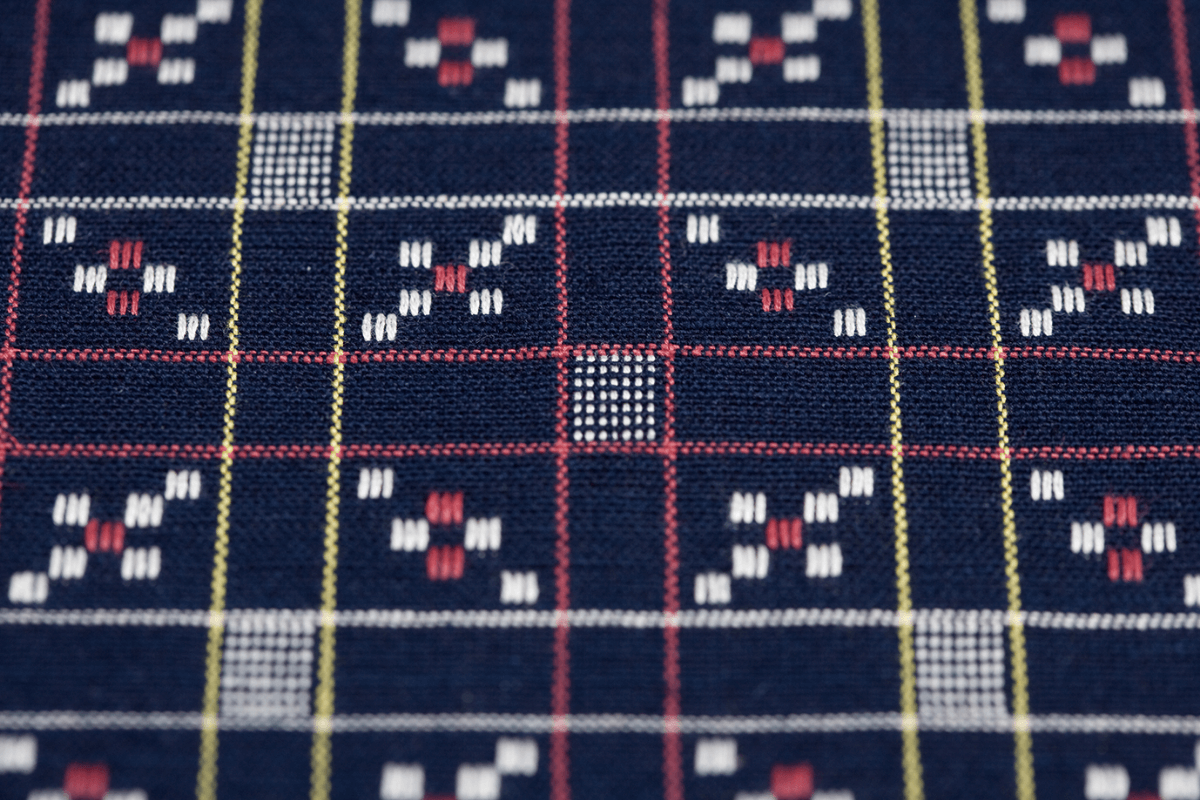
This fabric was woven in the former Misato Village (present Okinawa City) as clothing for festive and formal occasions. It is believed that the techniques and processes were established by the late 19th century. While most hana-ori weavings apply weft-floating (horizontal) weaving methods, the Chibana Hana-ori features warp-floating (vertical) weaving methods.
Shuri-ori
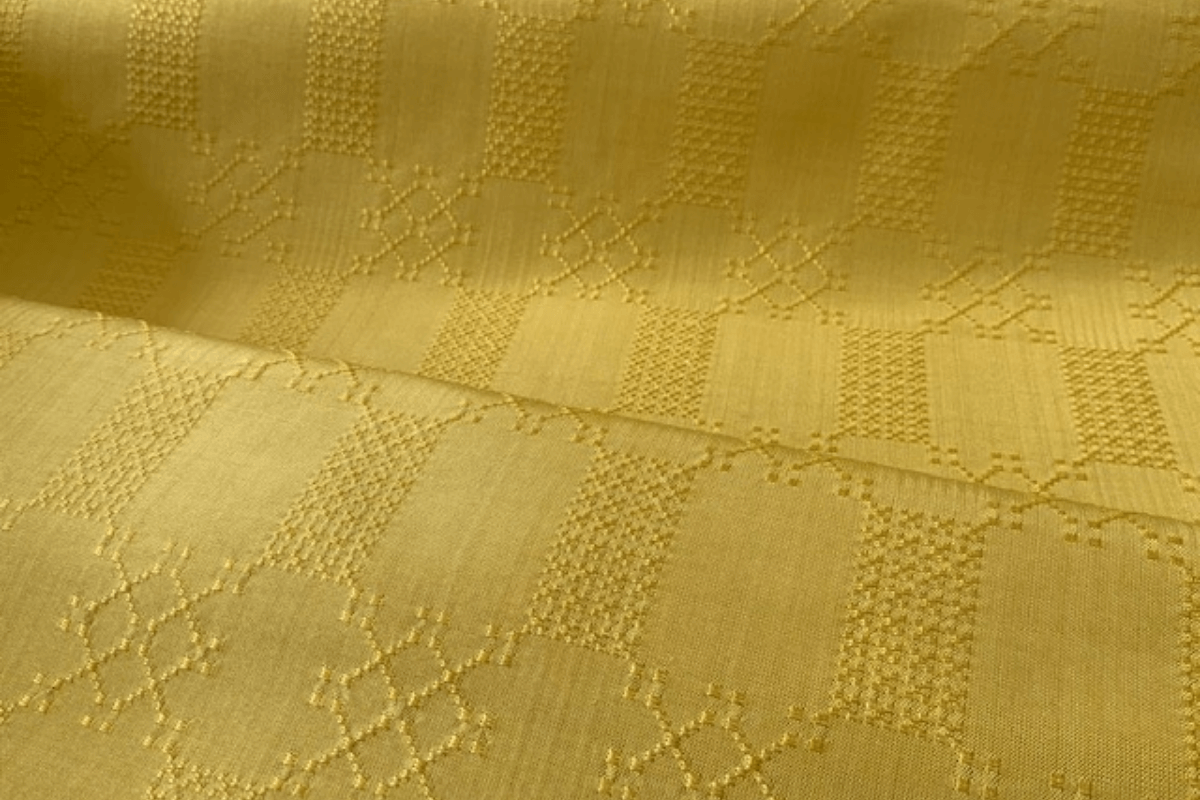
Shuri, which prospered as the ancient capital of the Ryukyu Kingdom, was strongly influenced by Southeast Asian countries and China around the 15th century, resulting in its unique textiles such as Kasuri(Ikat), Hana-ori, Roton-ori, Hanakura-ori and Minsā that is woven in this region. Shuri-ori is highly valued for its royal and sophistocated design and the warm texture the hand-woven process creates.
Ryukyu Kasuri
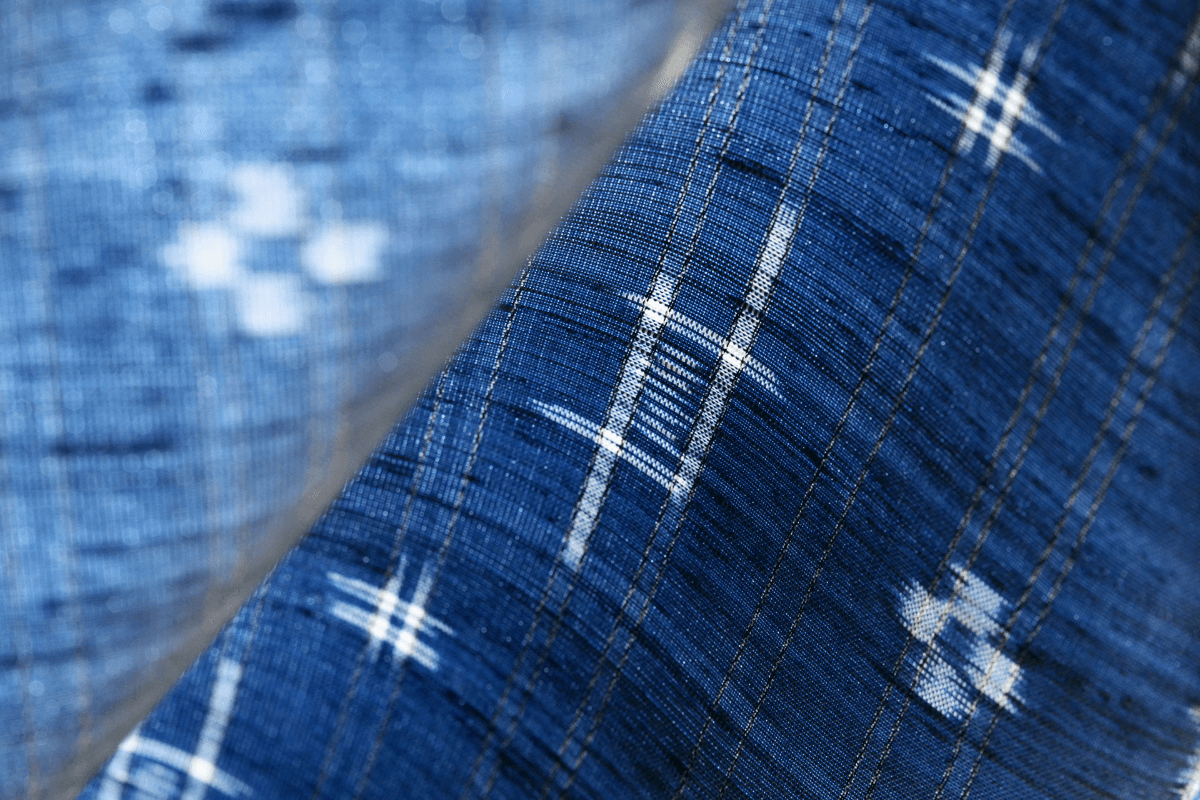
The Ryukyu Kasuri(Ikat) began in 1611 with the introduction of cotton seeds and weaving skills from the Satsuma Province (present Kagoshima area) of Japan. There are around 600 kinds of geometric patterns, many of which portray scenes of nature and everyday life. It is made using silk, cotton and hemp thread, and is known for its simple, neat and elegant style.
Haebaru Hana-ori
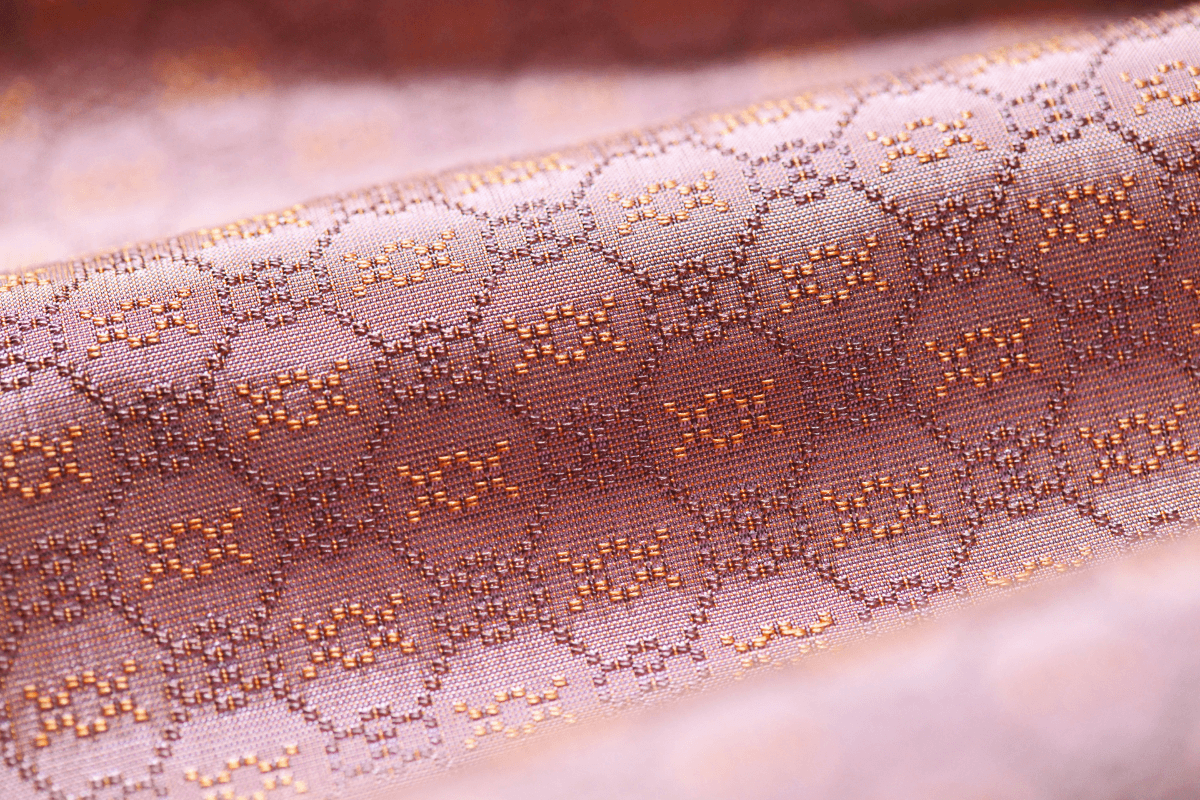
Haebaru Hana-ori features four types of Hana-ori (woven cloths): Ryomen-uki Hana-ori (double-floating Hana-ori) such as “Kyanhachimai” and “Tacchirī”, Tate-uki (Warp-floating) such as “Kwan-Kwan Hana-ori”, Nuitori-Ori such as “Chippugasā”, and Aya-ori such as “Haebaru Shamon-ori”.
Kume-jima Tsumugi
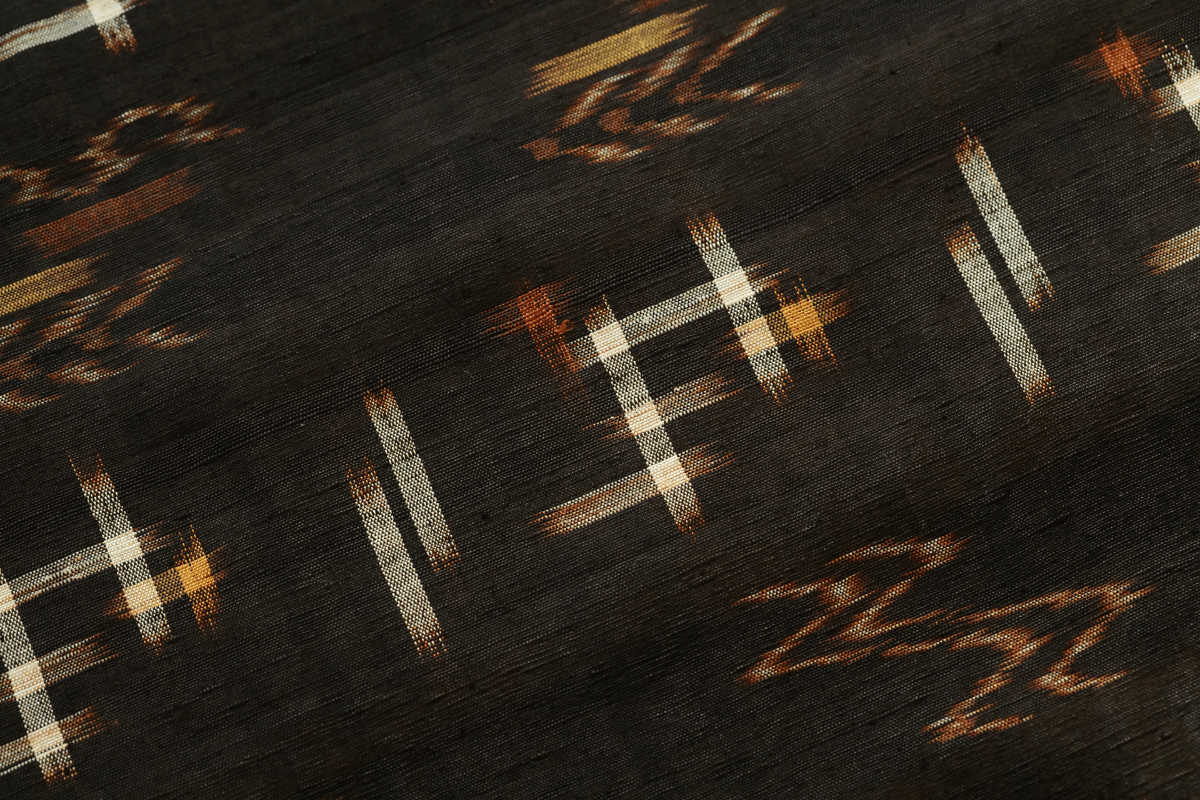
Kumejima Tsumugi is Okinawa’s oldest tsumugi weaving which originated 500 years ago when silkworm cultivation techniques were introduced from China. Applying the regional charactertistics, Kumejima Tsumugi is produced using traditional techniques such as the use of plant and mud dyes as well as cloth-beating (kinuta-uchi). It is highly valued for its durability and how comfortable it is.
Miyako Jōfu
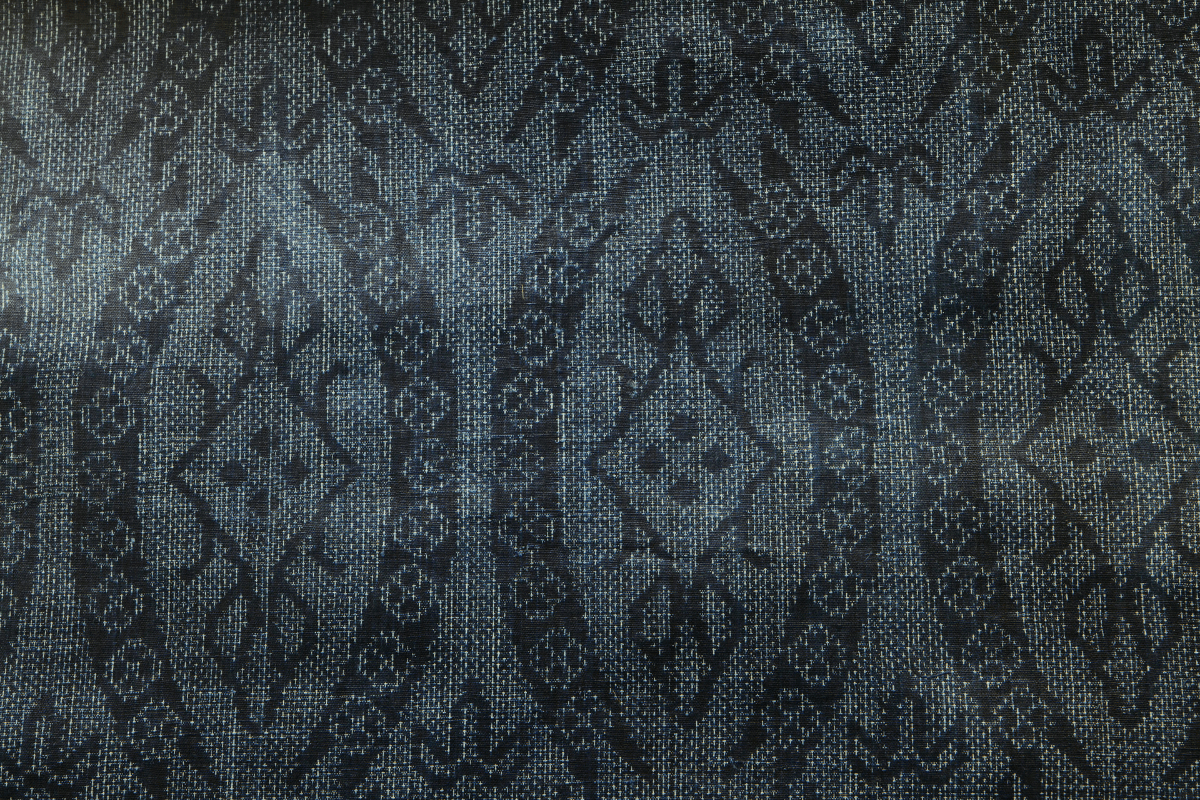
Miyako Jōfu originated in the late 16th century. During this period, wild-grown ramie was used for weaving. Thin thread is used, exquisite Kasuri (Ikat) is applied, and traditional methods such as indigo dyeing, hand-twisted thread, and hand-weaving techniques are applied. It is a highly valued fine navy blue fabric which represents the material used when making summer kimonos.
Yaeyama Jōfu
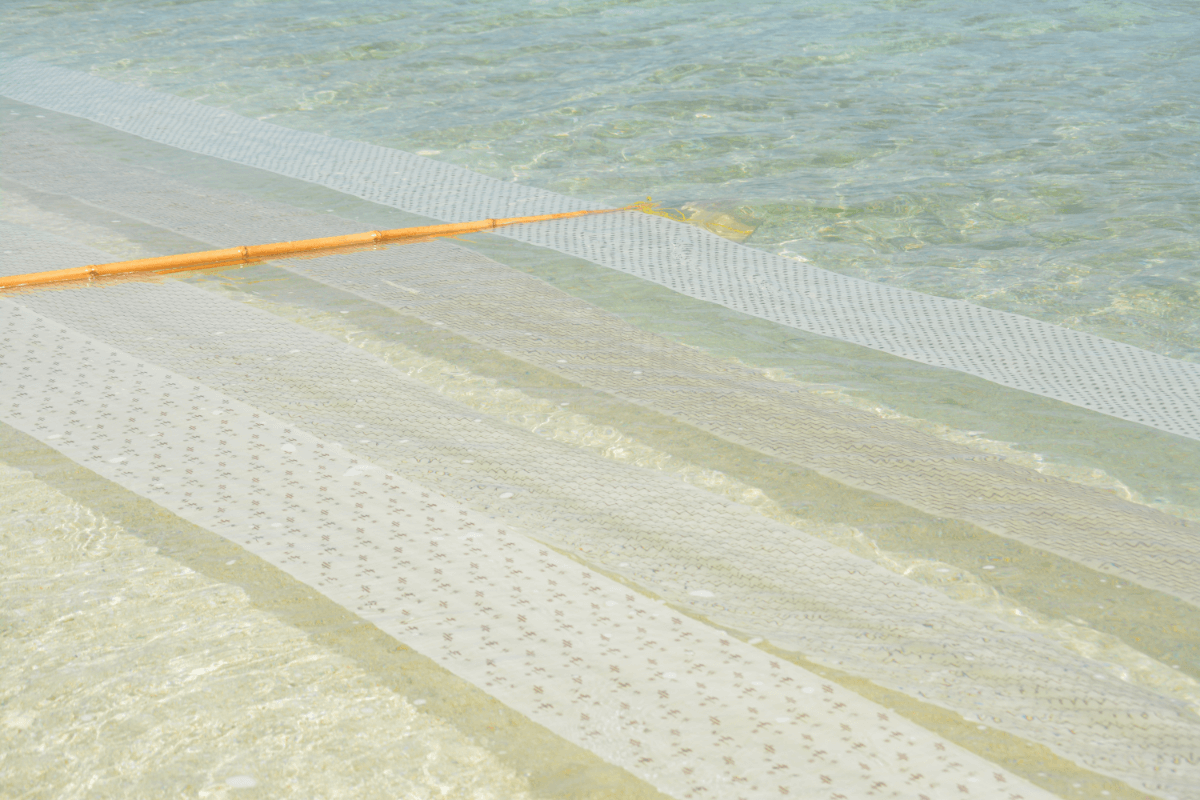
According to historical records, Yaeyama Jōfu was used as a gift offered to the Satsuma Province (present Kagoshima area) in the early 17th century. Produced from ramie, the Kasuri (Ikat) splashed pattern is either dyed by binding the marked areas of the threads or brush printed. To dye the fabric, plant dyes such as Ryukyu indigo and Kouro (red dye) are used. After weaving, the fabric is soaked in seawater to lighten its color. It becomes a fine white fabric suitable for the summer season that makes it look like the Kasuri (splashed patterns) are “floating” on the white cloth.
Yaeyama Minsā
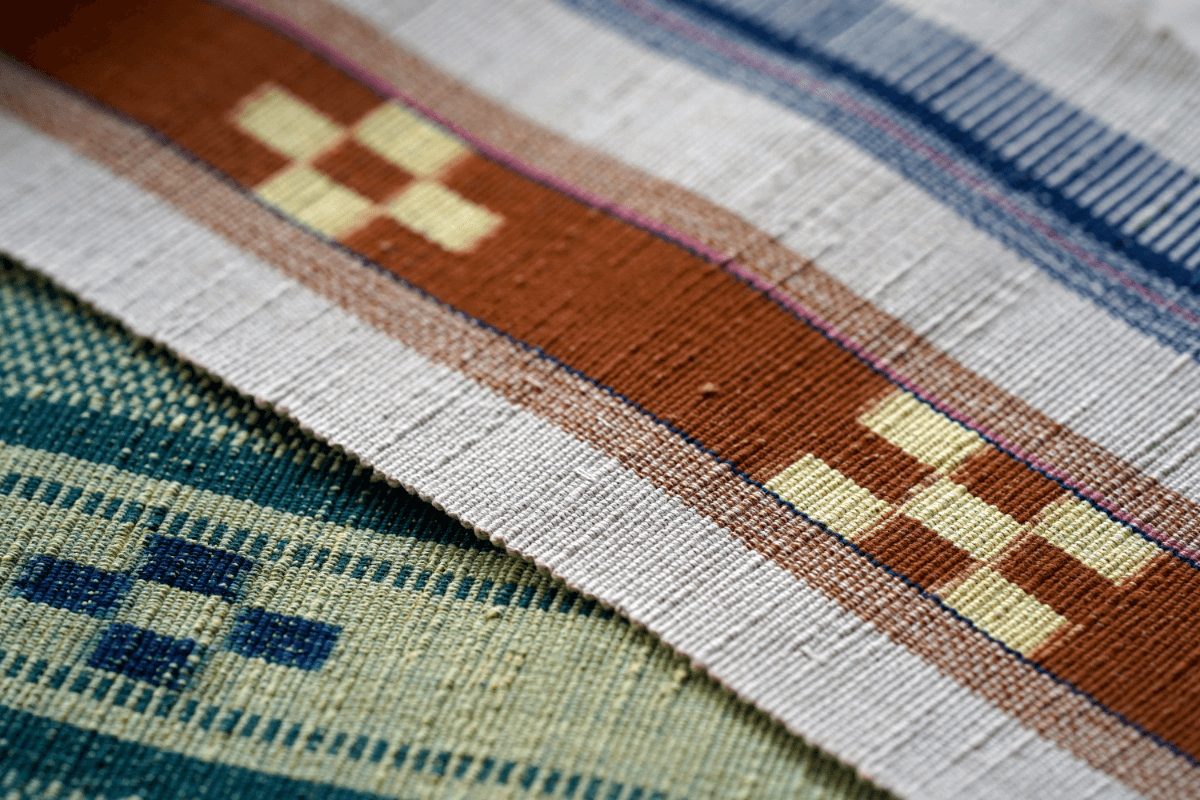
Yaeyama Minsā is a Kasuri(Ikat) splashed pattern fabric made from cotton thread dyed using plant dyes such as Indian indigo, Ryukyu indigo, Fukugi (Garcinia spicata-tree grown in tropical regions) and Kouro (red dye). Yaeyama Minsā is a type of fabric woven in a geometric, flower-like design mainly used to produce Obi (sashes for kimono), ties and bags with a tropical, bright touch. The alternating five-and-four square patterns of the Kasuri design holds the meaning of “wishing to be together eternally”.
Yonaguni-ori
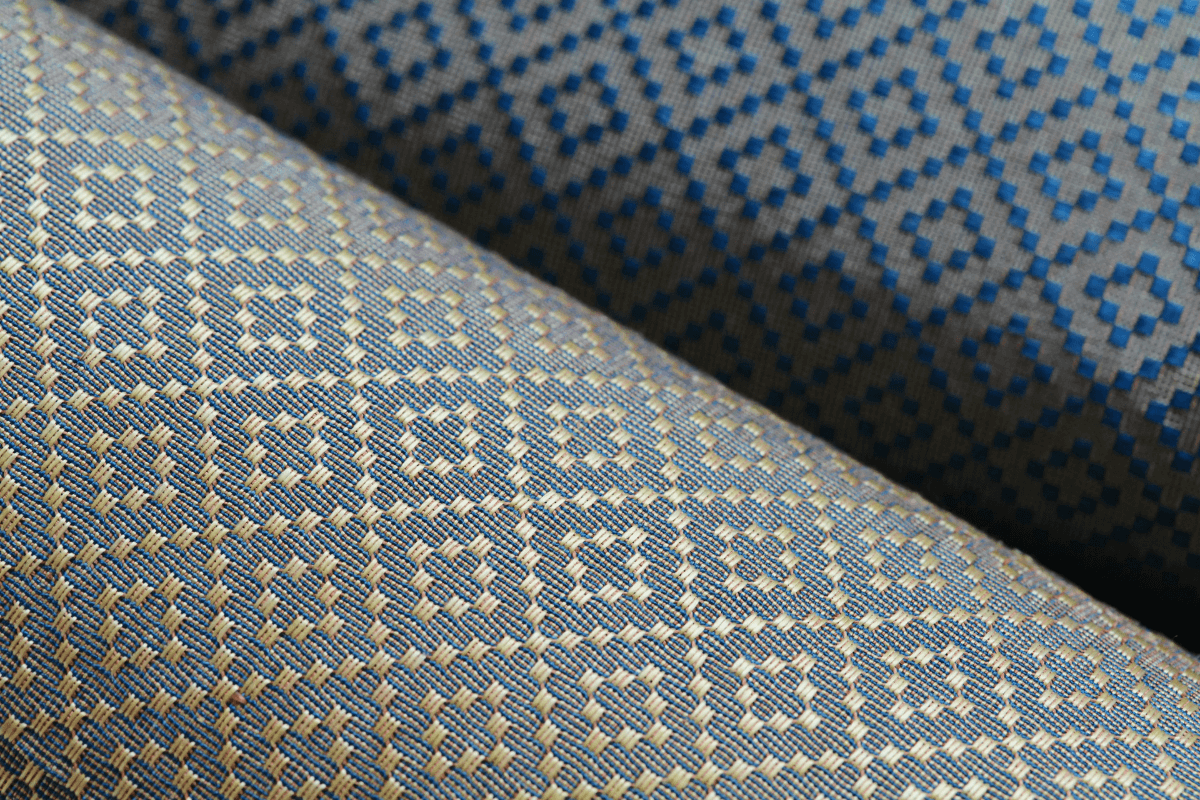
The origin of Yonaguni-ori is said to be unknown; however, records have been found stating the origin is as late at the 15th century. There are four weaving types of Yonaguni-ori: Yonaguni Hana-ori, Yonaguni Dutatī (striped textile), Yonaguni Kagannubū (Minsā), and Yonaguni Shidadī (hand towel). Materials such as silk, cotton and hemp thread are used, and local plant dyes are used for dyeing.
Urasoe-ori
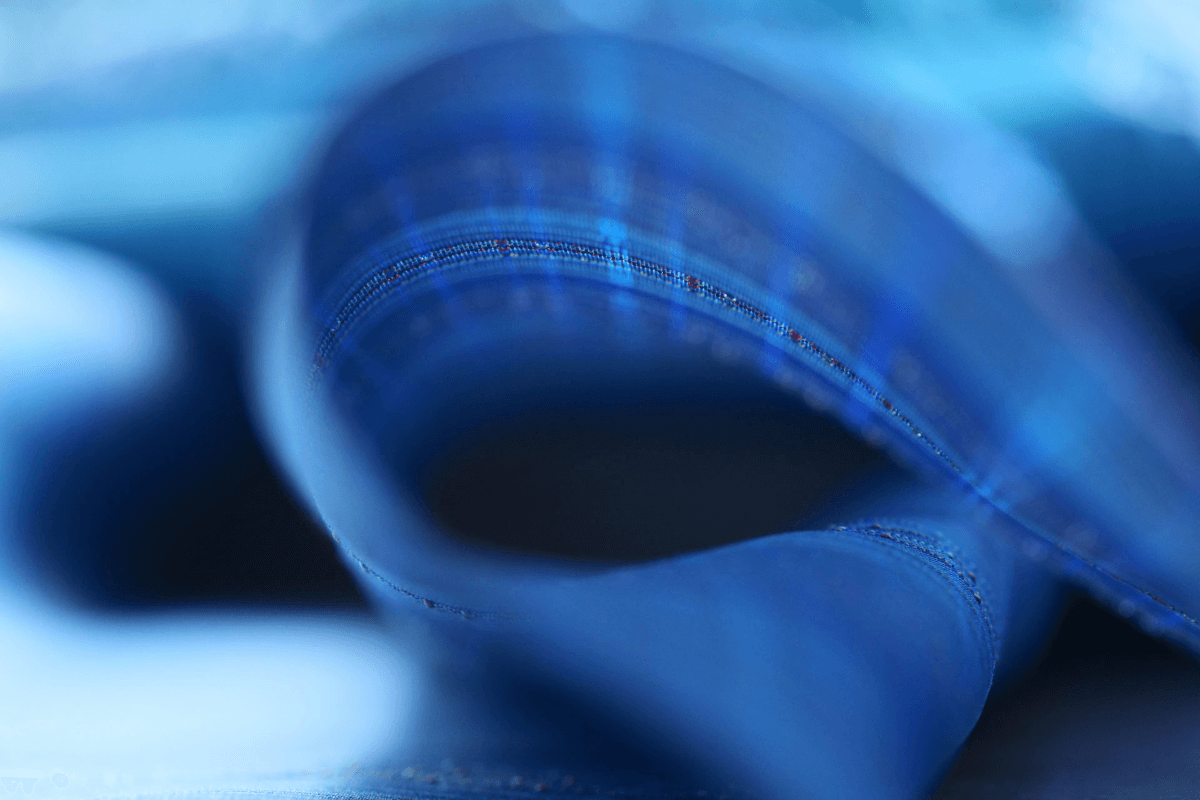
The entire manufacturing process of Urasoe-ori is operated by a single weaver, starting from the spinning of the thread harvested from cocoons of silkworms locally fed and grown to the dyeing and the weaving. The carefully hand-spun thread contains air in its thread, unlike mechanically spun thread; this quality thread is used to make a smooth and comfortable cloth.
 Originating in the 13th century, the Bashōfu fabric is made from the hand-spinning kasuri (ikat) threads, that are made from the bark of the Ito Bashō (fiber banana tree). After it is dyed with Ryukyu indigo, sharinbai (Rhaphiolepis indica var umbellate or Yeddo hawthorn), and other plant dyes, it is weaved into fabric. This woven fabric suits the Okinawa climate well and has been valued by locals since ancient time for its light and smooth texture.
Originating in the 13th century, the Bashōfu fabric is made from the hand-spinning kasuri (ikat) threads, that are made from the bark of the Ito Bashō (fiber banana tree). After it is dyed with Ryukyu indigo, sharinbai (Rhaphiolepis indica var umbellate or Yeddo hawthorn), and other plant dyes, it is weaved into fabric. This woven fabric suits the Okinawa climate well and has been valued by locals since ancient time for its light and smooth texture. Originating in the 15th century, the Yuntanza Hana-ui was once created to be the official fabric of the Ryukyu Kingdom, which only the royal family, nobilities, and residents of Yomitan were allowed to wear. It is a tropical fabric made of silk and cotton thread with geometric patterns expressed with colored thread, and then decorated with Kasuri(Ikat), stripes, and plaid patterns.
Originating in the 15th century, the Yuntanza Hana-ui was once created to be the official fabric of the Ryukyu Kingdom, which only the royal family, nobilities, and residents of Yomitan were allowed to wear. It is a tropical fabric made of silk and cotton thread with geometric patterns expressed with colored thread, and then decorated with Kasuri(Ikat), stripes, and plaid patterns. The Yuntanza Minsā originated around the same time as the Yuntanza Hana-ui and demonstrates strong influences from the Southeast Asia region. This fabric is made of cotton thread and a geometric, flower-like design that is woven into the warp using tools such as bamboo skewers. The word “Minsā” means a narrow belt or sash.
The Yuntanza Minsā originated around the same time as the Yuntanza Hana-ui and demonstrates strong influences from the Southeast Asia region. This fabric is made of cotton thread and a geometric, flower-like design that is woven into the warp using tools such as bamboo skewers. The word “Minsā” means a narrow belt or sash. This fabric was woven in the former Misato Village (present Okinawa City) as clothing for festive and formal occasions. It is believed that the techniques and processes were established by the late 19th century. While most hana-ori weavings apply weft-floating (horizontal) weaving methods, the Chibana Hana-ori features warp-floating (vertical) weaving methods.
This fabric was woven in the former Misato Village (present Okinawa City) as clothing for festive and formal occasions. It is believed that the techniques and processes were established by the late 19th century. While most hana-ori weavings apply weft-floating (horizontal) weaving methods, the Chibana Hana-ori features warp-floating (vertical) weaving methods. Shuri, which prospered as the ancient capital of the Ryukyu Kingdom, was strongly influenced by Southeast Asian countries and China around the 15th century, resulting in its unique textiles such as Kasuri(Ikat), Hana-ori, Roton-ori, Hanakura-ori and Minsā that is woven in this region. Shuri-ori is highly valued for its royal and sophistocated design and the warm texture the hand-woven process creates.
Shuri, which prospered as the ancient capital of the Ryukyu Kingdom, was strongly influenced by Southeast Asian countries and China around the 15th century, resulting in its unique textiles such as Kasuri(Ikat), Hana-ori, Roton-ori, Hanakura-ori and Minsā that is woven in this region. Shuri-ori is highly valued for its royal and sophistocated design and the warm texture the hand-woven process creates. The Ryukyu Kasuri(Ikat) began in 1611 with the introduction of cotton seeds and weaving skills from the Satsuma Province (present Kagoshima area) of Japan. There are around 600 kinds of geometric patterns, many of which portray scenes of nature and everyday life. It is made using silk, cotton and hemp thread, and is known for its simple, neat and elegant style.
The Ryukyu Kasuri(Ikat) began in 1611 with the introduction of cotton seeds and weaving skills from the Satsuma Province (present Kagoshima area) of Japan. There are around 600 kinds of geometric patterns, many of which portray scenes of nature and everyday life. It is made using silk, cotton and hemp thread, and is known for its simple, neat and elegant style. Haebaru Hana-ori features four types of Hana-ori (woven cloths): Ryomen-uki Hana-ori (double-floating Hana-ori) such as “Kyanhachimai” and “Tacchirī”, Tate-uki (Warp-floating) such as “Kwan-Kwan Hana-ori”, Nuitori-Ori such as “Chippugasā”, and Aya-ori such as “Haebaru Shamon-ori”.
Haebaru Hana-ori features four types of Hana-ori (woven cloths): Ryomen-uki Hana-ori (double-floating Hana-ori) such as “Kyanhachimai” and “Tacchirī”, Tate-uki (Warp-floating) such as “Kwan-Kwan Hana-ori”, Nuitori-Ori such as “Chippugasā”, and Aya-ori such as “Haebaru Shamon-ori”. Kumejima Tsumugi is Okinawa’s oldest tsumugi weaving which originated 500 years ago when silkworm cultivation techniques were introduced from China. Applying the regional charactertistics, Kumejima Tsumugi is produced using traditional techniques such as the use of plant and mud dyes as well as cloth-beating (kinuta-uchi). It is highly valued for its durability and how comfortable it is.
Kumejima Tsumugi is Okinawa’s oldest tsumugi weaving which originated 500 years ago when silkworm cultivation techniques were introduced from China. Applying the regional charactertistics, Kumejima Tsumugi is produced using traditional techniques such as the use of plant and mud dyes as well as cloth-beating (kinuta-uchi). It is highly valued for its durability and how comfortable it is. Miyako Jōfu originated in the late 16th century. During this period, wild-grown ramie was used for weaving. Thin thread is used, exquisite Kasuri (Ikat) is applied, and traditional methods such as indigo dyeing, hand-twisted thread, and hand-weaving techniques are applied. It is a highly valued fine navy blue fabric which represents the material used when making summer kimonos.
Miyako Jōfu originated in the late 16th century. During this period, wild-grown ramie was used for weaving. Thin thread is used, exquisite Kasuri (Ikat) is applied, and traditional methods such as indigo dyeing, hand-twisted thread, and hand-weaving techniques are applied. It is a highly valued fine navy blue fabric which represents the material used when making summer kimonos. According to historical records, Yaeyama Jōfu was used as a gift offered to the Satsuma Province (present Kagoshima area) in the early 17th century. Produced from ramie, the Kasuri (Ikat) splashed pattern is either dyed by binding the marked areas of the threads or brush printed. To dye the fabric, plant dyes such as Ryukyu indigo and Kouro (red dye) are used. After weaving, the fabric is soaked in seawater to lighten its color. It becomes a fine white fabric suitable for the summer season that makes it look like the Kasuri (splashed patterns) are “floating” on the white cloth.
According to historical records, Yaeyama Jōfu was used as a gift offered to the Satsuma Province (present Kagoshima area) in the early 17th century. Produced from ramie, the Kasuri (Ikat) splashed pattern is either dyed by binding the marked areas of the threads or brush printed. To dye the fabric, plant dyes such as Ryukyu indigo and Kouro (red dye) are used. After weaving, the fabric is soaked in seawater to lighten its color. It becomes a fine white fabric suitable for the summer season that makes it look like the Kasuri (splashed patterns) are “floating” on the white cloth. Yaeyama Minsā is a Kasuri(Ikat) splashed pattern fabric made from cotton thread dyed using plant dyes such as Indian indigo, Ryukyu indigo, Fukugi (Garcinia spicata-tree grown in tropical regions) and Kouro (red dye). Yaeyama Minsā is a type of fabric woven in a geometric, flower-like design mainly used to produce Obi (sashes for kimono), ties and bags with a tropical, bright touch. The alternating five-and-four square patterns of the Kasuri design holds the meaning of “wishing to be together eternally”.
Yaeyama Minsā is a Kasuri(Ikat) splashed pattern fabric made from cotton thread dyed using plant dyes such as Indian indigo, Ryukyu indigo, Fukugi (Garcinia spicata-tree grown in tropical regions) and Kouro (red dye). Yaeyama Minsā is a type of fabric woven in a geometric, flower-like design mainly used to produce Obi (sashes for kimono), ties and bags with a tropical, bright touch. The alternating five-and-four square patterns of the Kasuri design holds the meaning of “wishing to be together eternally”. The origin of Yonaguni-ori is said to be unknown; however, records have been found stating the origin is as late at the 15th century. There are four weaving types of Yonaguni-ori: Yonaguni Hana-ori, Yonaguni Dutatī (striped textile), Yonaguni Kagannubū (Minsā), and Yonaguni Shidadī (hand towel). Materials such as silk, cotton and hemp thread are used, and local plant dyes are used for dyeing.
The origin of Yonaguni-ori is said to be unknown; however, records have been found stating the origin is as late at the 15th century. There are four weaving types of Yonaguni-ori: Yonaguni Hana-ori, Yonaguni Dutatī (striped textile), Yonaguni Kagannubū (Minsā), and Yonaguni Shidadī (hand towel). Materials such as silk, cotton and hemp thread are used, and local plant dyes are used for dyeing. The entire manufacturing process of Urasoe-ori is operated by a single weaver, starting from the spinning of the thread harvested from cocoons of silkworms locally fed and grown to the dyeing and the weaving. The carefully hand-spun thread contains air in its thread, unlike mechanically spun thread; this quality thread is used to make a smooth and comfortable cloth.
The entire manufacturing process of Urasoe-ori is operated by a single weaver, starting from the spinning of the thread harvested from cocoons of silkworms locally fed and grown to the dyeing and the weaving. The carefully hand-spun thread contains air in its thread, unlike mechanically spun thread; this quality thread is used to make a smooth and comfortable cloth.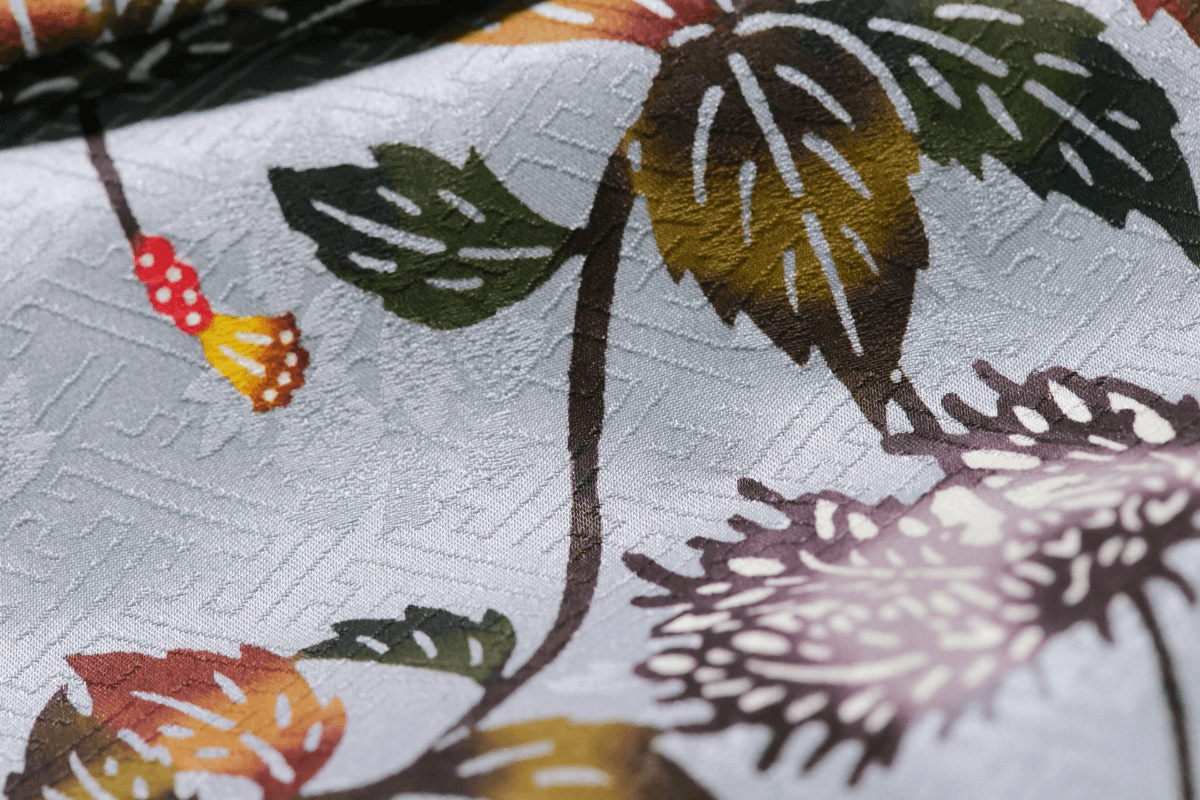 Bingata is the only traditional dyeing method in Okinawa, which was developed in the 15th century. Depending on the dyeing technique, the fabric is categorized into two types: katazome (stencil dyeing) and tsutsugaki (tube drawing, a method drawing directly onto the fabric). Bingata is colorfully hand-dyed on materials such as cotton, silk, bashō-fu (banana fiber cloth), using pigment and plant dyes, and Aigata (indigo style), a dipping dye technique that uses Ryukyu indigo. Each style has its own elegant attractiveness.
Bingata is the only traditional dyeing method in Okinawa, which was developed in the 15th century. Depending on the dyeing technique, the fabric is categorized into two types: katazome (stencil dyeing) and tsutsugaki (tube drawing, a method drawing directly onto the fabric). Bingata is colorfully hand-dyed on materials such as cotton, silk, bashō-fu (banana fiber cloth), using pigment and plant dyes, and Aigata (indigo style), a dipping dye technique that uses Ryukyu indigo. Each style has its own elegant attractiveness.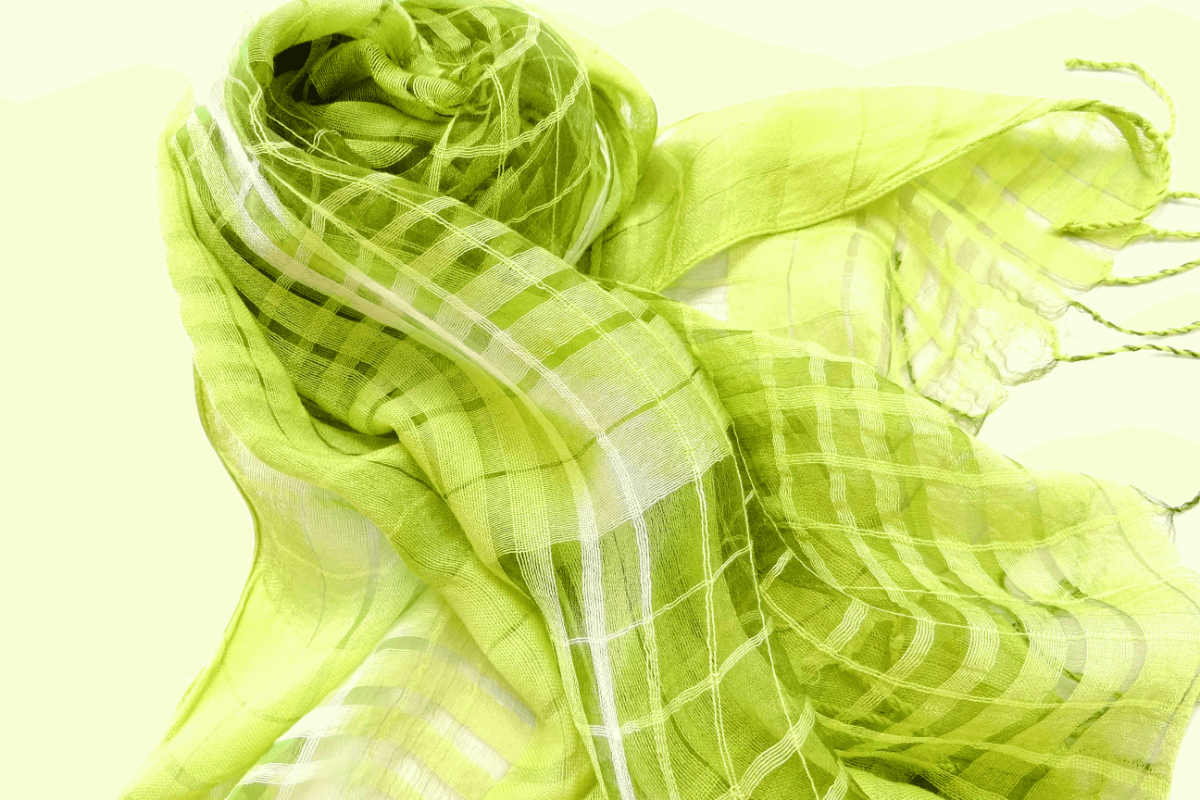 A village renewal project occurred in 1989 called the “Tomigusuku City Ūjizome”. The project developed a dyeing method and textile using Okinawan sugarcane. The color used for dyeing slightly differs depending on the time of the year the sugarcane is harvested, and as a result its natural texture and color becomes the unique characteristic of each product.
A village renewal project occurred in 1989 called the “Tomigusuku City Ūjizome”. The project developed a dyeing method and textile using Okinawan sugarcane. The color used for dyeing slightly differs depending on the time of the year the sugarcane is harvested, and as a result its natural texture and color becomes the unique characteristic of each product.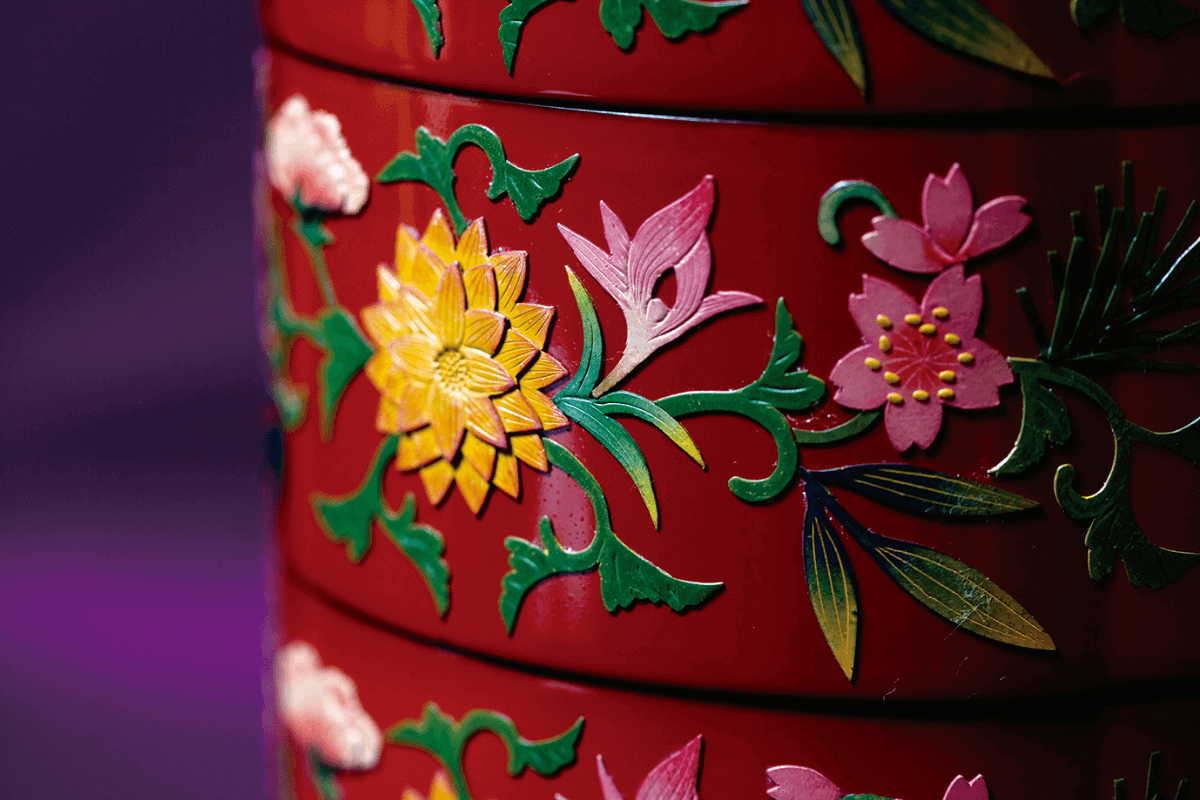 The origin is said to have begun in the late 14th century. The Ryukyu Laquerware is made by applying layers of natural laquer and the deep unique red color is painted onto wood such as “deigo” (Tiger’s Claw) and “egonoki” (Japanese Snowbell). Various decorative techniques such as the Okinawan original Tsuikin (a method of applying lacquer sticker, a technique original to Okinawa), Raden (mother-of pearl inlay), Chinkin and Hakue (gold and silver inlay) are applied to the laquerware.
The origin is said to have begun in the late 14th century. The Ryukyu Laquerware is made by applying layers of natural laquer and the deep unique red color is painted onto wood such as “deigo” (Tiger’s Claw) and “egonoki” (Japanese Snowbell). Various decorative techniques such as the Okinawan original Tsuikin (a method of applying lacquer sticker, a technique original to Okinawa), Raden (mother-of pearl inlay), Chinkin and Hakue (gold and silver inlay) are applied to the laquerware.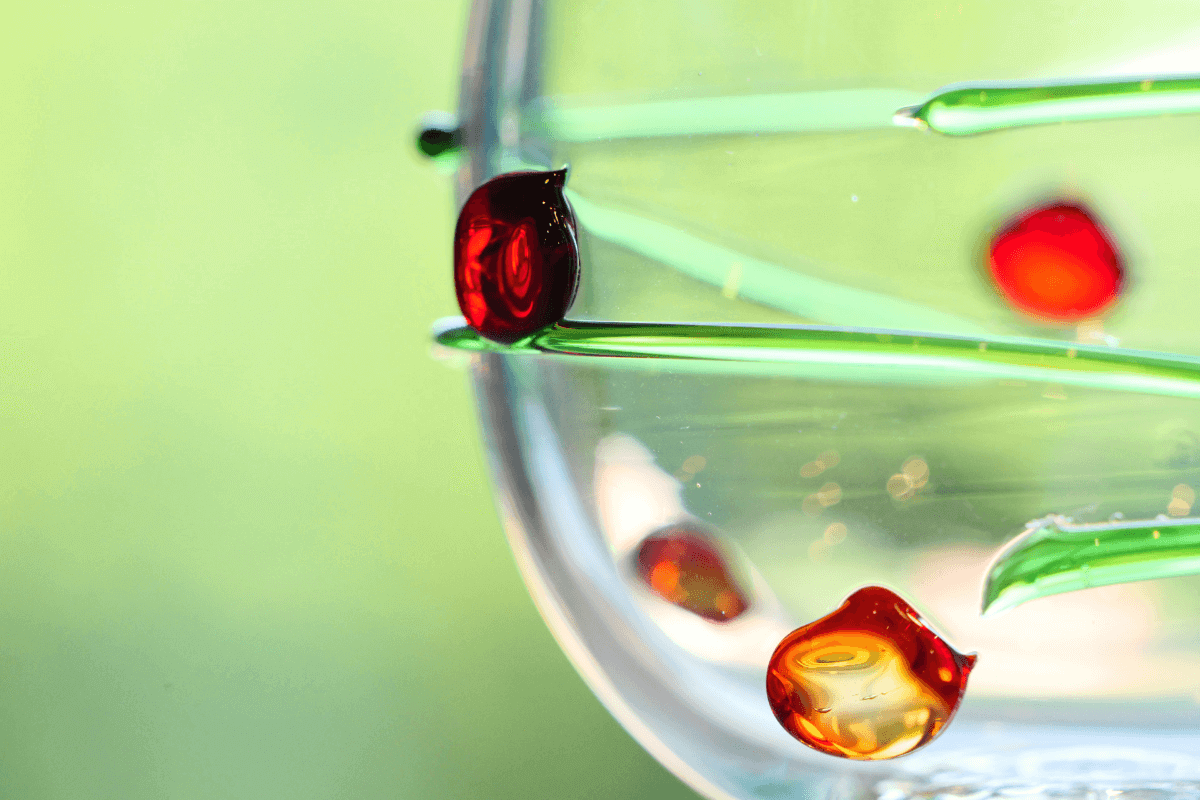 Lamps and medicine prescription bottles which were produced in the early Meiji era is said to be the beginning of the Ryukyu glassware. After the war, Ryukyu glassware were sold to the U.S. Military Forces stationed in Okinawa, which leads to today; daily necessities such as tableware and vases are highly valued as handmade Ryukyu glassware crafts.
Lamps and medicine prescription bottles which were produced in the early Meiji era is said to be the beginning of the Ryukyu glassware. After the war, Ryukyu glassware were sold to the U.S. Military Forces stationed in Okinawa, which leads to today; daily necessities such as tableware and vases are highly valued as handmade Ryukyu glassware crafts.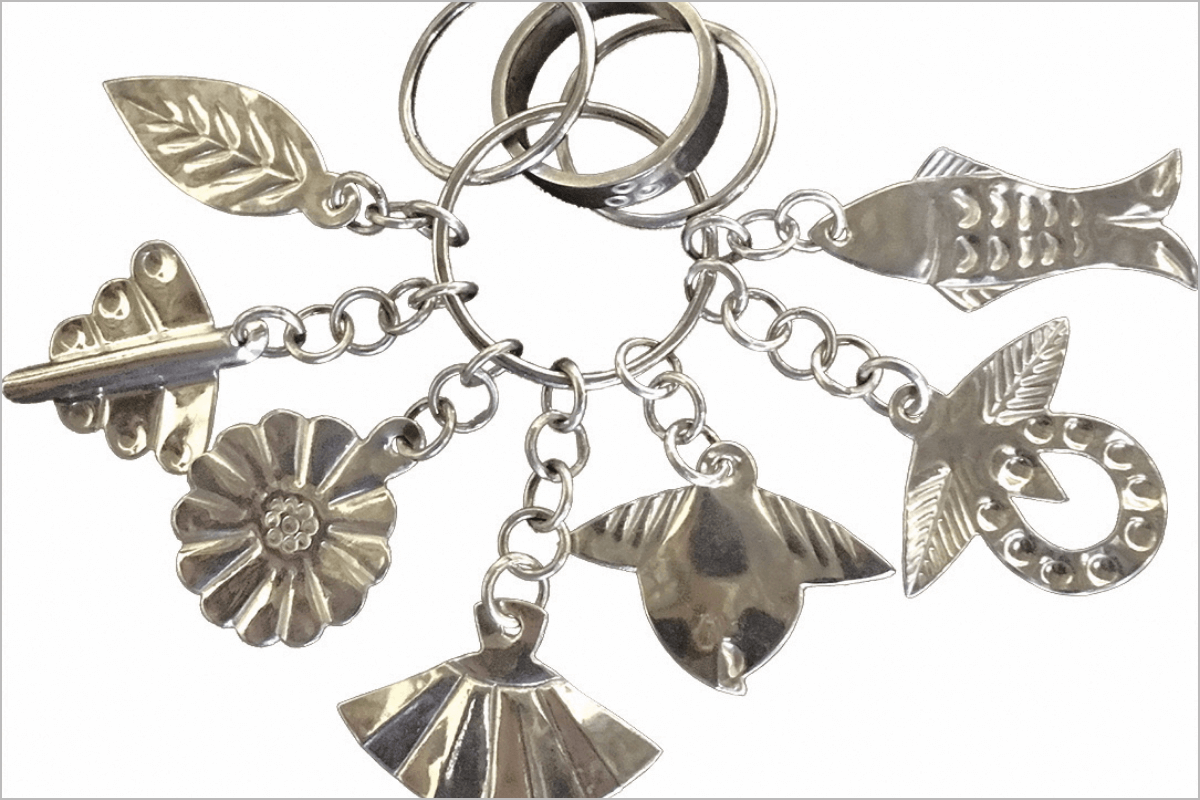 During the Ryukyu Kingdom era, many Goldsmiths opened craftshops near the Shurei-mon gate of Shurijo Castle. These craftsmen were called Kanzēku. Up until today, traditional Kinzaiku such as Jiifaa (a traditional Okinawan hairpin), Musubi-yibiwa and Fusa-yubiwa (types of rings), which have been passed down since the Ryukyu Kingdom era, are being made.
During the Ryukyu Kingdom era, many Goldsmiths opened craftshops near the Shurei-mon gate of Shurijo Castle. These craftsmen were called Kanzēku. Up until today, traditional Kinzaiku such as Jiifaa (a traditional Okinawan hairpin), Musubi-yibiwa and Fusa-yubiwa (types of rings), which have been passed down since the Ryukyu Kingdom era, are being made.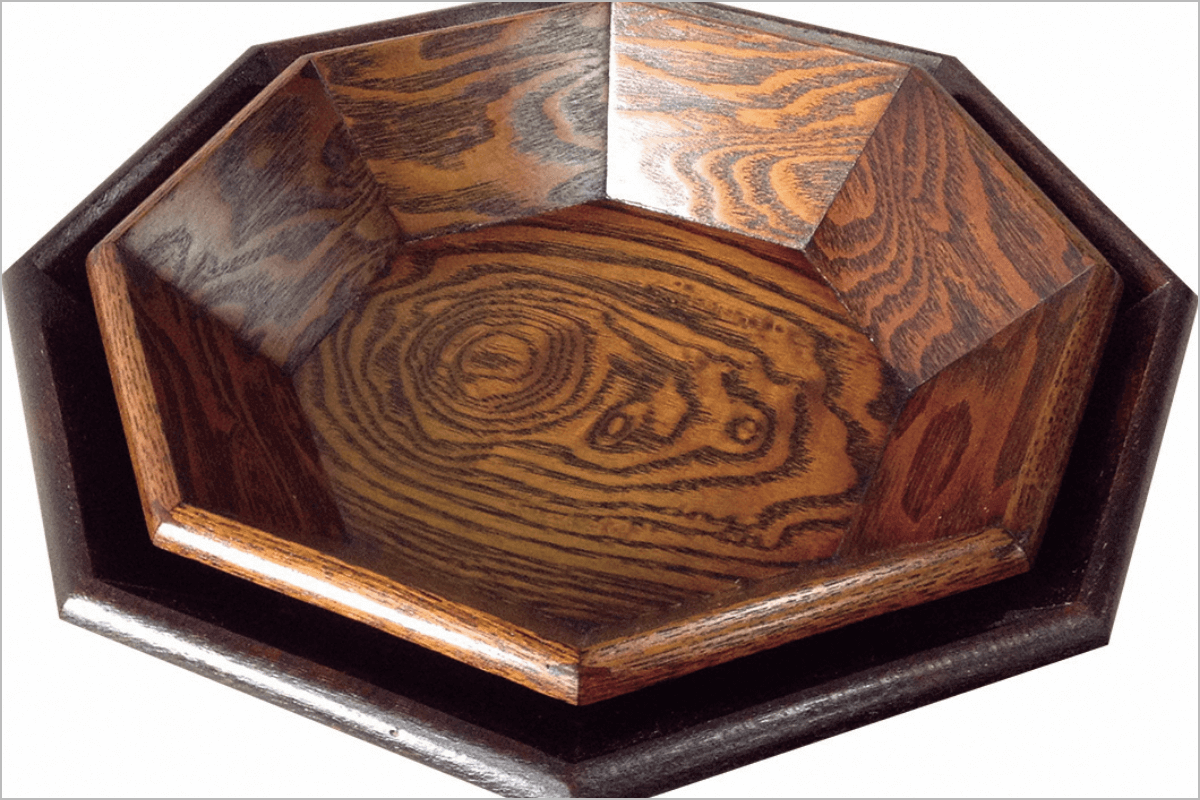 From 1975 onwards, woodcraft industry using wood from the Ryukyu Pine (Ryukyu Pinus luchuensis) and Japanese Chinquapin (Castanopsis siebldii) prospered. Technologies such as turning and joining of the wood, together with painting techniques advanced in the woodcrafting industry, which lead to the usage of woodcrafts in daily lives.
From 1975 onwards, woodcraft industry using wood from the Ryukyu Pine (Ryukyu Pinus luchuensis) and Japanese Chinquapin (Castanopsis siebldii) prospered. Technologies such as turning and joining of the wood, together with painting techniques advanced in the woodcrafting industry, which lead to the usage of woodcrafts in daily lives.

